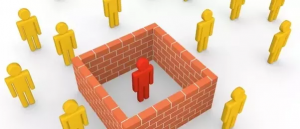Isolation & Apartments

The Lady Contractor
June 30, 2017
Mental Health Monday: Vacation?
July 10, 2017Recently, Eve Andrews took on the topic of isolation in apartment buildings in her article, Why a City Block Can Be One of the Loneliest Places on Earth.
This struck a chord with the Raza Properties team on many levels—maybe the most obvious being that we build apartments and have a genuine interest in tenants’ happiness, maybe it’s because we’ve each lived that existence to varying degrees ourselves. The existence that Andrews so eloquently describes as:…the intimacy of removing a complete stranger’s underwear from the building washing machine; the awkwardness of silent elevator rides while rubbing elbows with a fellow tenant; the jealous pangs of hurrying alone past a cluster of happy friends sharing pizza on your stoop. Or maybe it’s our growing awareness of the importance of community and the difficulty of authentically finding, creating, and preserving it in general, but in particular in a world where the individual is constantly striving and seeking and yet somehow coming up alone in crowded places.

Raza Properties has long acknowledged how development both impacts and is impacted by the political, financial, cultural, social, and emotional climate of an area. Andrews in her article, spends time exploring some of these connections, but specifically she looks at the link between technology, political involvement, building design, and housing makeup–each seemingly unrelated, but yet profoundly connected when looked at through a closer lens.
She goes on to also look at how events in history shaped the architecture of buildings and the fact that at one time it was considered a true advancement to be able to build “isolated developments in metropolitan areas.” Still, it seems that somewhere down the road we advanced too far for our own good and now struggle to connect with those next door, leaving some of us lonely and uncertain how to cultivate human connection.
The article shares a new concept (for some of us) called the, “empathic design.”
…championed by Van Der Ryn [empathic design] means creating a space that attends to a person’s needs, physical and emotional health, and “connection to others.” Empathic buildings have inviting common spaces for residents to interact, and access to green space and the outdoors. They feel integrated with the street and the buildings around them.”
While we don’t claim to build community compounds or to be evolved fully into 100% empathic design we are aware, listening, and see the importance of things like integrating green space where possible, proposing dog parks in our plans for meet ups, and efforts to include local businesses, restaurants, and coffee shops as integral pieces to what transforms a property into a home—Places where neighbors may meet, greet, contribute, and connect.
Human nature, architecture, gentrification, rent prices, work habits, immigration, shared culture, and community groups are all included in this thought provoking piece that is certainly worth a closer read and we encourage you to do that. We also invite you to comment below in response to this blog with suggestions on ways you personally have overcome isolation as a renter or new city dweller, links for local meet up groups, or other suggestions to combat this phenomenon of being so close to people…and yet so far.
The bottom line at Raza Properties we want our residents to not only feel comfortable inside the physical space we have created, we hope you feel a connection to the neighborhood, value its history, experience the richness of the city, and interact with the people who live next door, above, below, and around you.
Eve Andrews sums it up well when she advises those struggling with isolation or finding connection as a renter in a big city, “You may live in a building that you feel cuts you off from the world, in a city that feels cold to you. The building, however, isn’t going to change more quickly than you can. If you feel stifled and isolated, the best solution is to open the door and go outside.”




